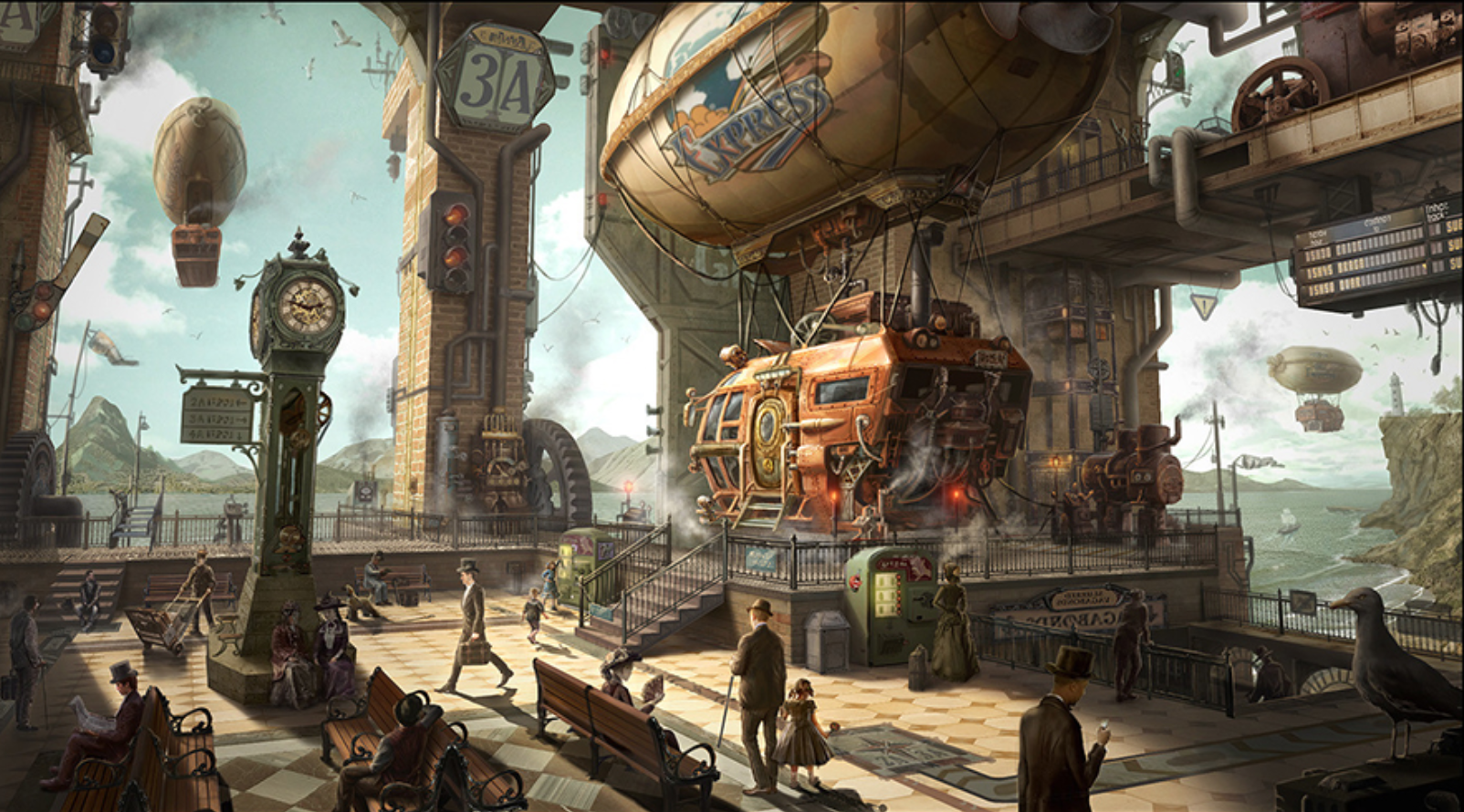Steampunk is an aesthetic that focuses on industrialization in the early 19th century. It often includes mechanical elements such as gears and engines, and highlights the interest of developing technology in the early 19th century. It aims to combine nostalgia of the past as well as mechanical speculation and fantasy of the future. Steampunk art is often very intricate and realistic looking, yet includes obvious aspects of fantasy. There are also steam engines as well as clock mechanisms. The aesthetic is characterized largely by flowing pieces that seem to have moving pieces. The term ‘steampunk’ was coined by K.W. Jeter in 1987 in order to depict a Victorian fantasy perspective on technology (Kaitlin Herbert, techtarget.com). Famous steampunk artists include Abney Park, Scott Westerfield, and Philip Reeve. Steampunk was largely influenced by Victorian literature, and 19th century industrialization along with fantasy. Science fiction plays another role in the creation of this aesthetic. It often includes imaginary technology and features the fantasy of technology in a futuristic light. Since its creation, steampunk has evolved into more than just wall art. There is literature depicting the steampunk aesthetic including stories about technological fantasy in the future, as well as steampunk bands. The aesthetic is often brought to life in real mechanical figures and statues, as well as the way people dress and the tattoos that people wear. Examples of these figures are below in figures 3 and 4. Being a mechanical engineer, my fascination with this aesthetic is rooted in the rugged, mechanical aspect that combines with my interest in future technology and engineering. I believe the future of this aesthetic will remain as a mechanics based feel, but will become even more rooted in the fantasy portion. An example of this idea is in figure 1, where large mechanical blimp-like machines are flying over a city, which seems to be in the early 19th century time period. Another good example of the fantasy aspect is included below in figure 2, where there is a large mechanical object sitting on an intricate dock. It is up to the viewer to interpret how this machine works in their own imagination. I believe that this aesthetic is a fantasy-based interpretation of history which makes it unique in its own way. Other creative pieces embrace this form as well, such as the frog figurine in figure 4, which has mechanical and fantasy aspects, but is not based on any particular time period. I think that this aesthetic is closely related to surrealism, which aims to merge fantasy with realism as well. Steampunk artists have an impressive ability to combine this world of fantasy with nostalgia from the past, this is done by avoiding bright colors, and keeping a more metallic feel to each piece. Some steampunk art is also purely metallic patterns, such as figure 6 below drawn by Matthias Hauser.

Figure 1: Vadim Voitekhovitch

Figure 2: Su Jeong Ahn

Figure 3: Cassia Harries

Figure 4: Michihiro Matsuoka

Figure 5: Matthias Hauser

Figure 6: Matthias Hauser
Works Cited:
Figures 1 and 2:
(1) Vadim Voitekhovitch, January 2024
(2) Su Jeong Ahn, January 2024
https://delifictional.com/steampunk-concept-art-list/
Figures 3 and 4:
(3) Cassia Harries, January 2024
(4) Michihiro Matsuoka, January 2024
https://cogpunksteamscribe.wordpress.com/2016/09/09/steampunk-art-and-the-steampunk-aesthetic/
Figures 5 and 6:
(5 and 6) Matthias Hauser, January 2024
https://matthias-hauser.pixels.com/collections/steampunk+art
What is Steampunk?, January 2024, https://www.techtarget.com/whatis/definition/steampunk#:~:text=Steampunk%20is%20a%20design%20style,especially%20technology%20powered%20by%20steam.
Steampunk Aesthetic, January 2024, https://steampunkscholar.blogspot.com/p/aesthetic-101.html


4 Comments. Leave new
Steampunk is a really interesting aesthetic and I couldn’t help but notice some of your examples almost look like they may have been generated by an AI? Particularly the dog, I just love how good artificial intelligence is getting at matching artforms such as this. Also the fractal spiral made by the same guy seems like it wouldn’t fit into the steampunk category, do you have another reason why you included it?
Thanks for the feedback Aj! I didn’t notice that the image may have been generated by AI when I was making the post, but now that I look back you might be right! It was taken from a famous steampunk artist Matthias Hauser, and I can not find information if it was created by AI or not, but I agree, it does have that visual effect that AI often creates. As for the fractal spiral, I was reading about other categories of art within steampunk, and some of them use metallic/mechanical elements derived from steampunk to create patterns like this one. The reason I included it is because I am planning on doing something similar with my upcycle project, where I will aim for the metallic pattern style of steampunk, but maybe stray away from the fantasy/ industrial aspect. Thanks for the comment!
I love the detail and level of information that your post has. However, I would suggest organizing this information into structured paragraphs so that the wonderful examples and information can be more easily understood by the reader.
Thanks Jess. I definitely agree and I will do my best to organize the post better, I am still trying to get used to this new platform but I think I am finally getting the hang of it.